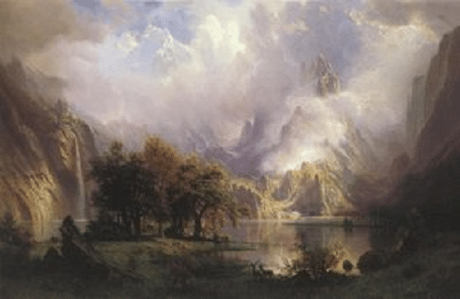Landscape paintings are one of the most tried and true art forms. Artists have tried to capture the world around them since the beginning of time. That being said, the art form has definitely evolved over the centuries to become the concept it’s known as today. From a mountain landscape painting to a beautiful sunset, this is a brief history of landscape paintings.

What Defines a Landscape Painting?
A landscape painting is generally accepted as a piece of art that focuses on natural scenery. While some landscape paintings feature human or manmade components but they aren’t the focal point of the painting. Common themes include mountainscapes, bodies of water, skyscapes, forests, coastlines, and more.
The First Landscape Paintings
While paintings of natural scenery have been around since the drawings that humanity’s prehistoric ancestors drew the sun on cave walls, the concept of landscape paintings as they’re known today first came about during the Classical periods and in ancient cultures such as those of Rome and Greece.
The modern concept of landscape paintings as a genre all their own, at least by the opinion of Western art historians, came about during the Renaissance period in which the genre was first labeled for what it was as it was created rather than retroactively. This occurred during the 16th century with artists such as Raphael, Michelangelo, and Da Vinci at the height of their careers.
In Eastern art historians’ opinions, the organized idea of landscape paintings as a genre is much older. With Eastern art history included in the full span of landscape artistry, the genre can be traced back to China in the 4th century.
Introduction of Landscape as an Artistic Term
While there is a debate, especially in the concept of Eastern vs. Western art, when the genre of landscape paintings began, the word “landscape” itself has artistic origins.
The English term was created for works of art around the beginning of the 17th century – well after even the accepted Western conception of the genre as a whole. It came into the English language as an anglicized version of a similar Dutch word, “landschap.”
A Classical Introduction of Landscape Paintings
One of the first recorded landscape paintings in Western history is from the Bronze Age. The piece was on a settlement in Santorini, a Greek volcanic island. The painting was a fresco in Akrotiri and, similarly to the likes of Pompeii, much of the island was covered and impressively preserved under the volcanic ash following an eruption. The eruption occurred in 1627 B.C. and the painting was found only relatively recently.
Landscape Paintings In Ancient Egypt
Ancient Egypt wasn’t left out of the artistic draw of landscapes either. Much of the landscape work done here wasn’t the focal point but rather as a background. For instance, paintings on the Nile often depicted hunters working as focal points on an exquisite background.
When landscapes were meant to be the focus, the idea of a broad, generalized landscape wasn’t the popular go-to. Instead, artists of this time often focused on details such as singular plant formations.
Ancient Egyptian art also showed early signs of a scaling technique in landscape painting. This was a way to give an image depth even when that image was recreated on a flat, two-dimensional plane.
Landscape Paintings in the Renaissance Era
During the Renaissance, landscape paintings became more popular because of their increased realism.
This partially thanks to the geometric advancements such as the concept of the ability to use lines of dimensions to create a more realistic scaling of the appearance of options in the foreground and background. This was a clear advancement on previously held scaling techniques such as those use in Ancient Egypt.
The idea that this leaned on was the idea of perspective or, in the then-modern Latin, perspicere. In other words, artists put a more mathematically advanced effort into conveying what they saw in front of them on a flat canvas or fresco.
Landscapes and Theme
One thing that often changes the appearance of a landscape painting is the theme alongside the style. For instance, in the 19th century, painters who focused on landscapes often used a more calming and realistic theme from a low perspective. This allowed them to capture a broader image of the landscape including the sky above.
In other art forms, such as narrative paintings, landscapes were used as a theme to push a more dramatic story. This was common in Biblically-themed paintings that had a dramatic flair.
Conclusion
Over time, the techniques of landscape paintings and the styles and artists who adopted them have changed. Even abstract art has taken the concept of landscape paintings and deconstructed them from the painstakingly picture-perfect accuracy of artists from eras such as the Renaissance. All in all, there’s a lot of art to explore, so don’t hesitate to look deeper into the genre of landscape paintings and the artists who made their name for this muse.
